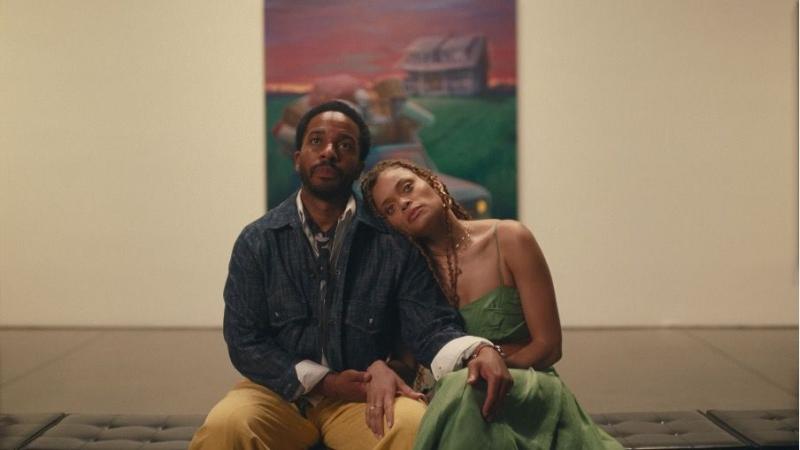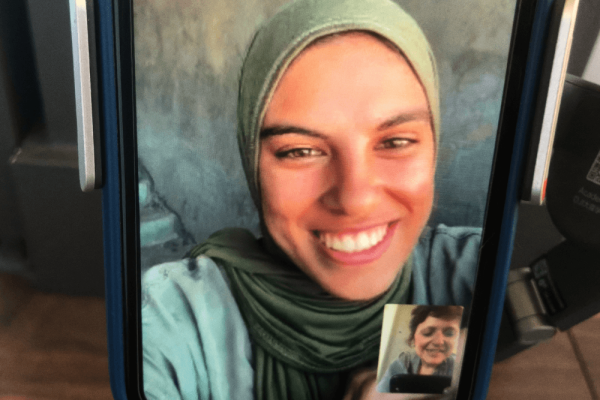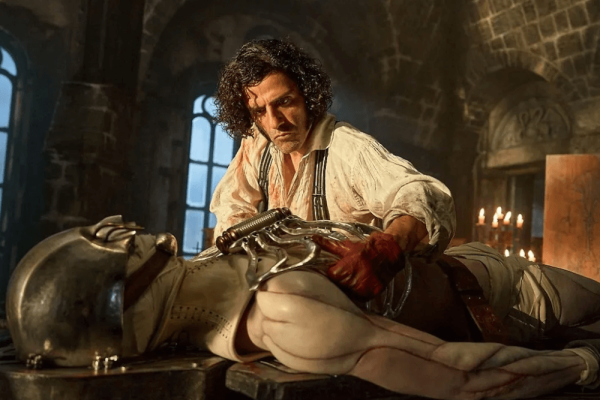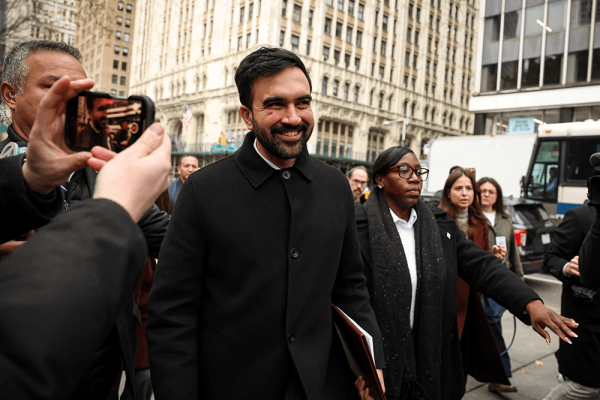This interview is part of The Reconstruct, a weekly newsletter from Sojourners. In a world where so much needs to change, Mitchell Atencio and Josiah R. Daniels interview people who have faith in a new future and are working toward repair. This week features a guest interview by Sojourners magazine associate editor Josina Guess. Subscribe here.
In the first few moments of Exhibiting Forgiveness, La’Ron (John Earl Jelks) is beaten after he defends a store clerk in a convenience store robbery. The violence, like most of the violence in the film, is just out of view. Soon the scene shifts and Tarrell (André Holland) wakes from a nightmare. His wife Aisha (Andra Day) reassures Tarrell that he is safe in the beautiful world they are building for themselves as artists and parents.
In his feature film debut, writer and director Titus Kaphar presents an autobiographical exploration of healing through art. Kaphar is a filmmaker, but he is first a painter. He sometimes deconstructs his canvases to reveal what is hidden behind the history of an image. This film exposes the images haunting Tarrell’s interior landscape and his process in becoming free from them.
Now playing in theaters, Exhibiting Forgiveness is one to see on the big screen. There are deeply satisfying auditory and visual moments as Holland, who learned to paint for the role of Tarrell, moves the brush across the canvas. Original art emerges and transforms along with the characters in the film. Day co-wrote the film’s theme song, “Bricks,” to honor Tarrell’s mother Joyce (Aunjanue Ellis-Taylor), a composite of Kaphar’s living mother and deceased grandmother. Kaphar had originally intended to make a documentary and the paintings and real-time songwriting blur the lines between fiction and life.
It is also important to see it in the theaters because it was made by a Black artist about Black families without using any of the stereotypes or tropes so common in films about Black people. Although the film centers on traumatic childhood memories, Kaphar was intentional about not retraumatizing viewers in the telling.
The movie shows the way unquestioned interpretations of the Bible can keep people, especially women and children, trapped in abusive relationships. In “Bricks,” Day sings of a new foundation, “built with bricks that we were never given.” We need more movies like this to lovingly examine and question toxic patterns in churches and families and move the needle toward individual and collective healing.
In our interview, Kaphar spoke about his religious upbringing, his love for his family, and the power of vulnerability.
This interview has been edited for length and clarity.
Josina Guess, Sojourners: What were the messages you learned about forgiveness when you were growing up?
Titus Kaphar: Before my father’s challenges, he was a minister; and my grandfather was a minister also. I grew up in the COGIC tradition — The Church of God in Christ. And those people loved me and cared for me and cherished me. I am very much who I am as a result of that.
I also realize that some of the ways that we taught forgiveness from the pulpit had a tendency to lead folks who were the victims of certain kinds of circumstances to reinjuring themselves, because they felt obliged to go back to dangerous situations because it was their spiritual duty to forgive. I watched my mother, my aunt, my grandmother, many of the women in that tradition forgive men who continued to do damage in their lives. There was a grace and a dignity from the women of the church that was always willing to forgive. In that tradition, Jesus’s death on the cross cleanses all sins, and you can come back at any point.
As I got older and started to see some of these situations repeat themselves again and again, it felt like just forgiving is not the answer. It’s not acceptable. There has to be some other kind of way to forgive. Forgiving doesn’t mean — shouldn’t have to mean — that you are putting yourself back in a situation that is dangerous for you or dangerous for your family.
You can forgive and go a different path. I can say, “I no longer choose to carry this burden. You owe me no debt, but we are parting ways now.” And that’s for self-preservation.
But the kind of forgiveness that I was taught or modeled was more along the lines of, “If you’ve really forgiven, then you should be able to forget.” And that’s just not reality. I think it’s damaging to tell people, particularly victims, that they need to forgive sometimes atrocities and also just forget without giving them the space to go through a process to reconcile the necessary challenges within themselves and the pain and the hurt within themselves. It no longer aligns with my beliefs.
What helped you forge a more liberatory approach to forgiveness and intergenerational healing? What brought you to where you are?
My children. It seemed clear to me that it was necessary for me to stop painting my father as a pure villain in my head, the villain of my personal narrative. I tried really hard in the film not to do that; to show his humanity. But the reality is addiction and recovery, in particular, are journeys. It’s not a single moment. The person doesn’t just wake up today recovered. A lot of people have gotten prayer to be released from their addictions and are still on that journey.
And even though we still love those folks on that journey and care for those folks, depending on where they are in that journey, it may not be safe to have them engage with people who are still growing and vulnerable.
I guess what I’m trying to say is as my father was going through what he was going through, I recognized that I was unwilling to allow the emotional and psychological swings process have an impact on my children. I made a decision that I was going to put some space between my father and my children. I didn’t want my children to have to go through the same kind of worries and wondering about where grandpa is and what happened at night.
My entire life I’ve lived with this fear. Whenever my aunts called me, I would just freeze up because I was convinced that they were going to tell me that my father had died in an alley somewhere. So, I just was not willing to allow my children to have to go through that kind of worry; not until I was clear that my father was further along on his journey.
andre_holland_and_andra_day_in_exhibiting_forgiveness_courtesy_of_roadside_attractions_884264af11.jpg

Has he seen the film, or has making the film been a way of communicating with him?
I made the film for my children and for my aunts and aunties and grandmother and my mother. My father’s making the choices and living with the consequences of those choices.
What was important to me is the women of the church, who are the ones who really raised me. My grandmother woke up at 4 o’clock in the morning every day and prayed for all of her grandchildren. I made this film for them. And when my aunts and my mother, when they’ve seen the film, their reaction is the thing that’s made me feel like I’ve done something significant for our family.
But as far as my father goes, I don’t think he’s seen the film.
That scene where a nail pierces young Tarrell’s foot was the most graphically violent scene, with a closeup of bloodshed. And I immediately thought of the iconography of crucifixion. Was that an intentional allusion?
I don’t think, having grown up in the tradition that I grew up in, that you can puncture flesh with a nail and not have it involve the crucifixion a little bit. But in this context, it comes up more as a question: Should it be okay to sacrifice this son?
Your question actually made me want to point out something: The film was really about an artist who has these images stuck in his head. He can’t really escape from them. It was important to me that I made a film that wasn’t doing that same thing; that wasn’t creating these images that were depictions of women getting beat or children getting beaten. I wanted to make sure that is not visually what I was leaving people with. So even when there is a moment of domestic violence, it’s abstracted in a way that you never actually see it.
I’m haunted enough by that stuff. I don’t need to pass it on. I wasn’t trying to exaggerate and take advantage of the viewers’ emotions. I wanted to tell a story and leave space for people to feel whatever it is that they felt without orchestrating unnecessary violence.
Many of your paintings, especially the Jerome Project, have a very devotional quality. Do you see your art as a spiritual practice? There’s no wrong answer.
I’m okay with wrong answers. If you don’t understand my grandmother’s faith, you don’t understand my grandmother. It was a fundamental part of who she was and what she taught us. Our entire value system is rooted in that, and that is rooted in me. And although my spiritual practice doesn’t look like what my grandmother might have wanted it to have been, I think she would recognize it as honest and sincere and very much rooted in the values that she taught me.
I hope that my paintings, my film, my art, [all] my work honors her and everything that she taught me and everything that she sacrificed for me and my mother. There’s never a time where I won’t be connected to that faith tradition because the people who loved me most in the world are from there.
andre_holland_in_exhibiting_forgiveness_credit_roadside_attractions_6017682d24.jpg

There’s a very intense scene at the end where Tarrell confronts an art collector at a gallery opening who feels a sense of ownership of Tarrell’s work. Was that something you’ve done at a show or towards a collector, or was it more like a cathartic “This is what I wish I could say” moment?
It’s a bit of a combination. I have had to confront collectors before because they have believed somehow that the acquisition of a painting is the purchase of me, and that’s not what it is. There’s this very strange nomenclature in the art world where people will say, “I own Titus Kaphar,” as opposed to, “I own a Titus Kaphar painting.” As a Black man, I will correct that language every single time it’s spoken to me.
The history of this country makes that unacceptable. So, I have had those conversations, I have had those confrontations — never at an opening. I do have collectors who have my artwork on their ceiling, and I do have collectors who take these devotional paintings, as you call them, and hold them more as commodities than they do as some kind of portal to some artistic spiritual experience. And that’s challenging for me.
I feel blessed to be where I am in my career and have the opportunities that I have. To make a living as an artist is a statistical anomaly. And that’s not lost on me. But at the same time, my motivation for making what I make is not the economics, it never has been, it never will be.
I’m still one of these crazy people who believes that art has the power to change the world, and if we treat it as such, we just might make a better place for ourselves. I know that’s super, super naive. I know that’s probably not cool to say, but I do. I really do. This film has made that clearer to me than anything else I’ve ever made in my career.
We did a screening of the film in Birmingham, Alabama, and we had 2,000 people show up. And it was Black and white and brown. It was everyone who was at the screening. And at the end of the film, this huge white guy came up to me in tears. And he said, “I know there’s differences between us. Obviously, you have that whole Black thing. But that was my father too. And I’ve never seen anything like that on film before. I don’t cry at movies. And I just wanted to come over and just thank you and give you a hug.”
In a moment in the world where there is so much division, to have those kinds of beautiful connections happen reassured me that if we create honest work, if we create vulnerable work, it allows space for other people to connect.
I’ve never thought that there’s anything that I made that was universal. I’ve never believed that was even an outcome that I could reach. But what I’m discovering is the more vulnerable and open you’re willing to be in your work, the more likely it is that your humanity will show, and in that humanity, other people will see themselves reflected, and that is the closest thing to making something universal as I think we can get.
Got something to say about what you're reading? We value your feedback!







